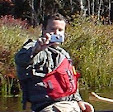 |
| Our cabin at Riverdrivers |
The Dead is a
classic New England whitewater river with 14 miles of continuous rapids. Releases are controlled from the Flagstaff Lake Dam above Grand
Falls. Releases can range from 1,200 cfs (class II) to 7,000 cfs (Class IV+). Last year I ran an 1,800 cfs release. This year, I would be stepping it up
by running a 3,500 cfs release (class III) on Saturday, followed by a 2,400 cfs release (class
II/III) on Sunday.
I arrived at Andy’s house at around
10:00 on Friday for the six hour drive up to West Forks, ME. We arrived at our
cabin at Riverdrivers (formerly known as Webb’s Campground) at around 4:30 and
began to unpack. Paul, Pat and Jon
arrived a couple of hours later.
We lit a fire and settled in for the night in anticipation of a great
weekend.
 |
| The shuttle bus at the put-in |
When we arrived, the put-in was busy with
rafting companies and boaters getting ready to launch. The release was 3,500
cfs, with another 450 cfs coming from the Spencer Stream for a total of 3,950
cfs – a solid class III. We hooked up with Kelly, Wayne and Andy and headed
downstream.
The first major rapid on the river
is the Spencer Rips – a short but intense rapid with 2 – 3 foot waves that sets the
tone for the rest of the trip. As
I bobbed my way down the rapid, I saw Jon up ahead of me flip, and then quickly
roll back up again. I knew that it
was going to be a fun and busy day.
 |
| Jon running Spencer Rips |
At this level, the rapids came at
us fast and furious, and we did have a few swims along the way. Everyone got a chance to rescue boats
and paddlers – except me. By the
time I reached the bottom of most of the rapids my boat was full of water and I
was looking for a place to bail.
I really need to get a pump!
My only swim was in a long rocky
rapid known as “Mile Long” - you
can guess why it has that name.
About half way down, I went over a rock into a hole filling my boat with
water. Now it’s possible to paddle
a swamped canoe, but it’s difficult.
My options were to try to bail out the canoe while bouncing down the
rapid, or try to work my way over to shore. I decided to paddle over to shore, and got about 15' before I dumped and took a swim.
 |
| Andy running Gravel Pit |
Swimming through rapids is
something that I try to practice, but it doesn’t match the real
experience. First, I swam though a
series of “haystacks” or standing waves where you breathe in the trough, and
hold you breath as you go through the wave - breathe, glug, breathe, glug,
breathe, glug. If this continues long enough, it can be though to catch your breath. Fortunately, it was a short set of haystacks.
After the waves, I could see a
horizon line downstream indicating that I was approaching a rock with a hole on
the other side. I tucked into a
ball as the pour over pulled me down into the hole. When I came out the other side, I swam hard toward shore. Fortunately, Pat had been working my
boat toward the same spot. It was just a
short time before I was back in my boat, but the two most difficult rapids
remained – Upper and Lower Poplar.
 |
| Jon in Lower Poplar |
Day one was complete. It had been a tough day with six of our
eight paddlers swimming at least once, and a total of nine swims in all. The run took us six hours. Still, it was a lot of fun, and we were
looking forward to another run on Sunday.



No comments:
Post a Comment
Note: Only a member of this blog may post a comment.